英语形容词的比较级
- 格式:wps
- 大小:28.00 KB
- 文档页数:4
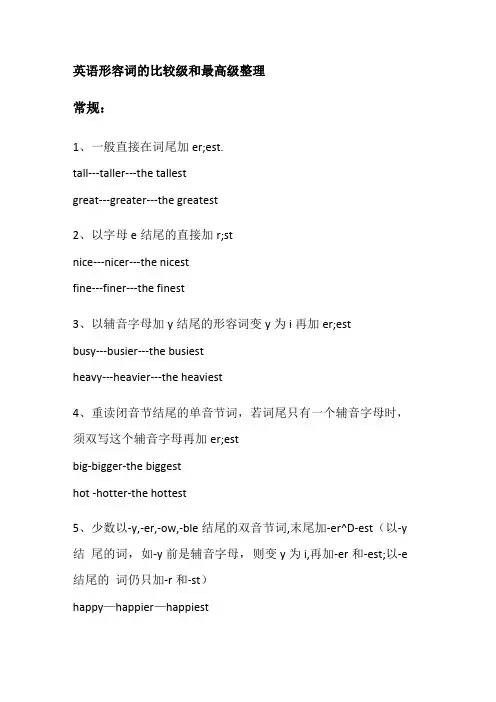
英语形容词的比较级和最高级整理常规:1、一般直接在词尾加er;est.tall---taller---the tallestgreat---greater---the greatest2、以字母e结尾的直接加r;stnice---nicer---the nicestfine---finer---the finest3、以辅音字母加y结尾的形容词变y为i再加er;estbusy---busier---the busiestheavy---heavier---the heaviest4、重读闭音节结尾的单音节词,若词尾只有一个辅音字母时,须双写这个辅音字母再加er;estbig-bigger-the biggesthot -hotter-the hottest5、少数以-y,-er,-ow,-ble结尾的双音节词,末尾加-er^D-est(以-y 结尾的词,如-y前是辅音字母,则变y为i,再加-er和-est;以-e 结尾的词仍只加-r和-st)happy—happier—happiestclever—cleverer—cleverest5、多音节和部分双音节词在词前加more、mosteasily--more easily--most easilybeautiful--more beautiful--the most beautiful特殊:(1 )有些单音节词的比较等级常用more和most,如glad,fond,shy,sly(但like 只可用more 和most)。
Eg:I am not more glad than you.我可没像你那样高兴。
Uncle Jack was more like a book of reference to my father.杰克大叔对我父亲来说真是一部参考书。
(2)有些单音节词用-er和-est或more和most皆可,如free,clear 等。
Eg:I'm clearer/more clear about it than before.对这事,我比以前更清楚了。
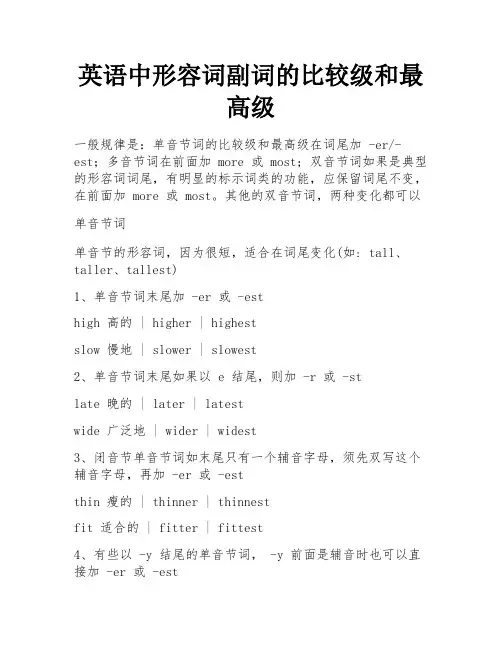
英语中形容词副词的比较级和最高级一般规律是:单音节词的比较级和最高级在词尾加 -er/-est;多音节词在前面加 more 或 most;双音节词如果是典型的形容词词尾,有明显的标示词类的功能,应保留词尾不变,在前面加 more 或 most。
其他的双音节词,两种变化都可以单音节词单音节的形容词,因为很短,适合在词尾变化(如: tall、taller、tallest)1、单音节词末尾加 -er 或 -esthigh 高的 | higher | highestslow 慢地 | slower | slowest2、单音节词末尾如果以 e 结尾,则加 -r 或 -stlate 晚的 | later | latestwide 广泛地 | wider | widest3、闭音节单音节词如末尾只有一个辅音字母,须先双写这个辅音字母,再加 -er 或 -estthin 瘦的 | thinner | thinnestfit 适合的 | fitter | fittest4、有些以 -y 结尾的单音节词, -y 前面是辅音时也可以直接加 -er 或 -estshy 害羞的 | shyer | shyestsly 狡猾的 | slyer | slyestwry 讽刺的 | wryer | wryest多音节词三个音节以上的多音节词已经很长,不适合再加词尾变化,因而在前面加 more 或 most,表示更(最)...,或者加 less 或least ,表示更(最)不...interesting 有趣的 | more interesting | most interestingimportant 重要的 | less important | least importantcarefully 认真地 | more carefully | most carefully双音节词双音节形容词很尴尬:不长不短,怎么判断?1、词尾是典型的形容词词尾,有明显的标示词类的功能,应保留词尾不变,在前面加 more 或 mostcrowded more crowded most crowdedloving more loving most lovinghelpful more helpful most helpfulfamous more famous most famousactive more active most active2、其他的双音节形容词,如果不是典型的形容词字尾,变化则无限制,两种变化都可以often oftener(more often) oftenest(most often)shallow shallower(more shallow) shallowest(most shallow)3、如果是 -y 结尾,这个长母音因为发音上的要求,要先变成短母音的 i,再加字尾变化,如:happy happier happiestlucky luckier luckiest二、不规则形式good/well | better | bestbad/ill/badly | worse | worstmany/much | more | mostlittle | less | leastfar | farther/further | farthest/furthestold | older/elder | oldest/eldest三、比较等级英语中形容词副词有三个比较等级,即原级、比较级和最高级1、原级(1) 表示程度相同,即“和...一样...”时用原级,常用"as... as" 结构It is as beautiful as paradise in Heaven. 这里如天堂般美丽This room is as broad as it is long. 那个房间长宽相等He is as handsome as John (is). 他和约翰一样英俊He studies as hard as John (does). 他和约翰一样努力(2) as...as... 引导的结构可采用倒装句型He studies as hard as John (does). = He studies as hard as does John.He is as handsome as John is. = He is as handsome as is John.(3) 否定的原级用 not as...as 或not so...as,二者区别不大You are not as tall as he. 你没有他高Guangzhou is not as clean as Shanghai. 广州没有上海那么干净I didn't do so well as I should. 我做得不如我应做得那么好(4) as/so... as... 结构前可以用 just、quite、almost、nearly、half 等词在程度上加以修饰This story was quite as interesting as we had thought. 这个故事和我们想的一样精彩The bike is not half so new as mine. 这辆自行车还没我的一半新She can read twice as fast as he does. 她的阅读速度比他快一倍John is not quite as good a student as his sister.连接词 as 表示这是组 as..as 的比较级。
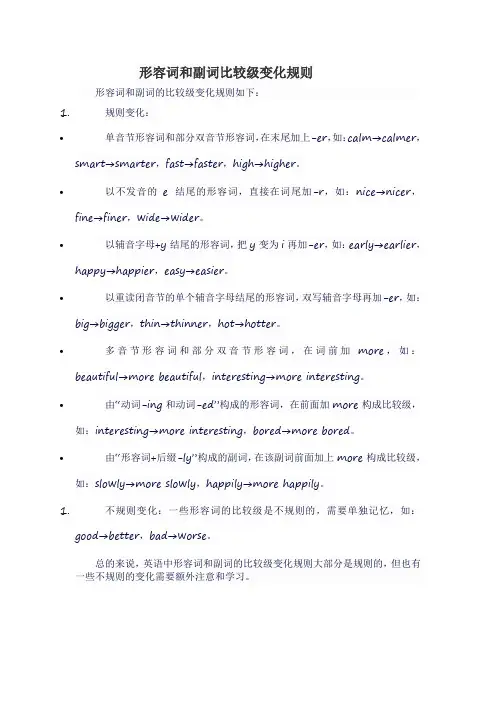
形容词和副词比较级变化规则
形容词和副词的比较级变化规则如下:
1.规则变化:
•单音节形容词和部分双音节形容词,在末尾加上-er,如:calm→calmer,smart→smarter,fast→faster,high→higher。
•以不发音的e结尾的形容词,直接在词尾加-r,如:nice→nicer,fine→finer,wide→wider。
•以辅音字母+y结尾的形容词,把y变为i再加-er,如:early→earlier,happy→happier,easy→easier。
•以重读闭音节的单个辅音字母结尾的形容词,双写辅音字母再加-er,如:big→bigger,thin→thinner,hot→hotter。
•多音节形容词和部分双音节形容词,在词前加more,如:beautiful→more beautiful,interesting→more interesting。
•由“动词-ing和动词-ed”构成的形容词,在前面加more构成比较级,如:interesting→more interesting,bored→more bored。
•由“形容词+后缀-ly”构成的副词,在该副词前面加上more构成比较级,如:slowly→more slowly,happily→more happily。
1.不规则变化:一些形容词的比较级是不规则的,需要单独记忆,如:good→better,bad→worse。
总的来说,英语中形容词和副词的比较级变化规则大部分是规则的,但也有一些不规则的变化需要额外注意和学习。
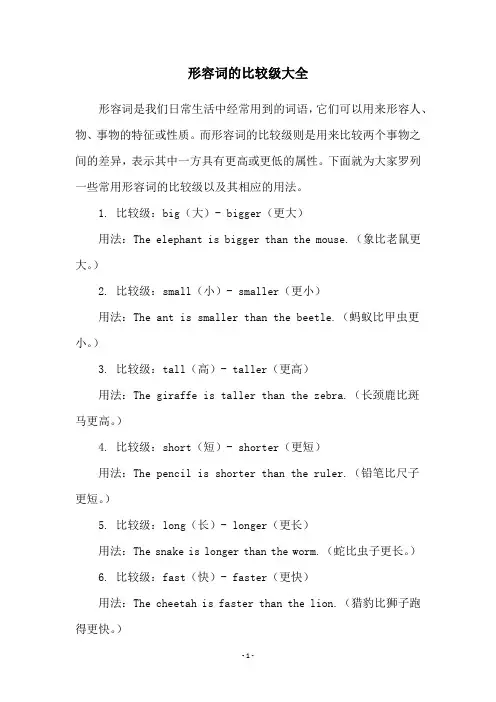
形容词的比较级大全形容词是我们日常生活中经常用到的词语,它们可以用来形容人、物、事物的特征或性质。
而形容词的比较级则是用来比较两个事物之间的差异,表示其中一方具有更高或更低的属性。
下面就为大家罗列一些常用形容词的比较级以及其相应的用法。
1. 比较级:big(大)- bigger(更大)用法:The elephant is bigger than the mouse.(象比老鼠更大。
)2. 比较级:small(小)- smaller(更小)用法:The ant is smaller than the beetle.(蚂蚁比甲虫更小。
)3. 比较级:tall(高)- taller(更高)用法:The giraffe is taller than the zebra.(长颈鹿比斑马更高。
)4. 比较级:short(短)- shorter(更短)用法:The pencil is shorter than the ruler.(铅笔比尺子更短。
)5. 比较级:long(长)- longer(更长)用法:The snake is longer than the worm.(蛇比虫子更长。
) 6. 比较级:fast(快)- faster(更快)用法:The cheetah is faster than the lion.(猎豹比狮子跑得更快。
)7. 比较级:slow(慢)- slower(更慢)用法:The turtle is slower than the rabbit.(乌龟比兔子跑得更慢。
)8. 比较级:easy(容易)- easier(更容易)用法:The multiple-choice test is easier than the essay test.(选择题比论述题更容易。
)9. 比较级:difficult(困难)- more difficult(更困难)用法:Calculus is more difficult than algebra.(微积分比代数更困难。
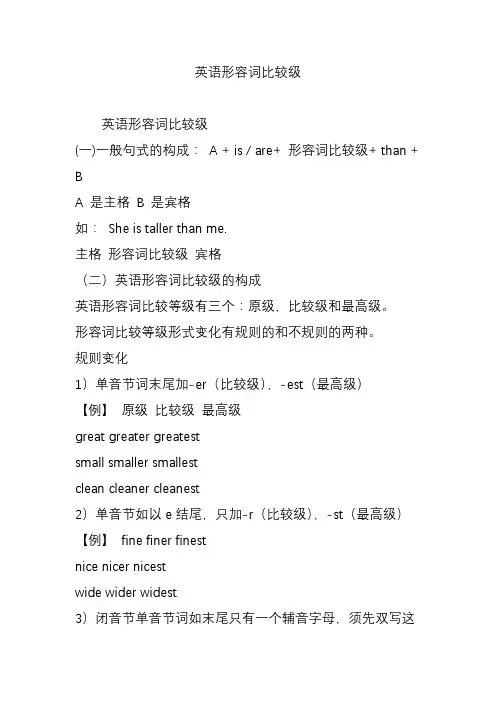
英语形容词比较级英语形容词比较级(一)一般句式的构成:A + is / are+ 形容词比较级+ than + BA 是主格B 是宾格如:She is taller than me.主格形容词比较级宾格(二)英语形容词比较级的构成英语形容词比较等级有三个:原级,比较级和最高级。
形容词比较等级形式变化有规则的和不规则的两种。
规则变化1)单音节词末尾加-er(比较级),-est(最高级)【例】原级比较级最高级great greater greatestsmall smaller smallestclean cleaner cleanest2)单音节如以e结尾,只加-r(比较级),-st(最高级)【例】fine finer finestnice nicer nicestwide wider widest3)闭音节单音节词如末尾只有一个辅音字母,须先双写这个辅音字母,再加-er(比较级),-est(最高级)【例】big bigger biggesthot hotter hottestred redder reddest 4)少数以-y,-er,ow,-ble结尾的双音节词,末尾加-er(比较级),-est(最高级)。
以-y结尾的词,如-y前是辅音字母,则变y为-i,再加-er和-est。
以-e结尾的词只加-r和-st。
【例】clever cleverer cleverestnarrow narrower narrowestable abler ablesteasy easier easiest5)其它双音节和多音节词皆在前面加单词more和most。
【例】careful more careful most carefuldifficult more difficult most difficultdelicious more delicious most delicious不规则变化原级比较级最高级good/well better bestbad worse worstmany/much more mostlittle less leastfar farther/further farthest/furthest注:有些形容词一般没有比较等级。
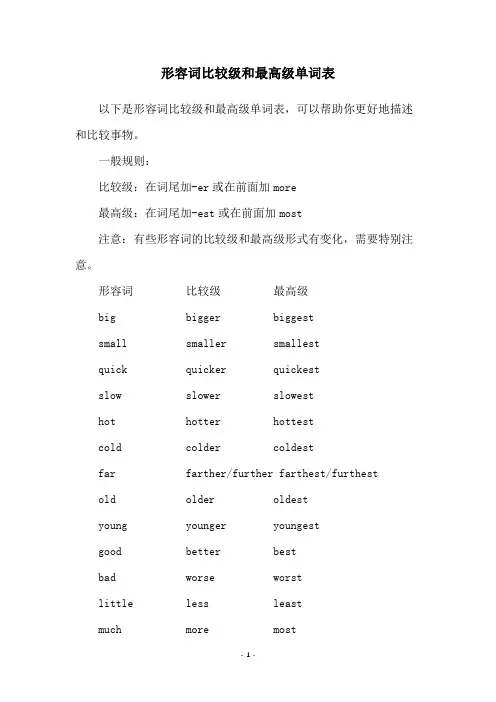
形容词比较级和最高级单词表以下是形容词比较级和最高级单词表,可以帮助你更好地描述和比较事物。
一般规则:比较级:在词尾加-er或在前面加more最高级:在词尾加-est或在前面加most注意:有些形容词的比较级和最高级形式有变化,需要特别注意。
形容词比较级最高级big bigger biggestsmall smaller smallestquick quicker quickestslow slower slowesthot hotter hottestcold colder coldestfar farther/further farthest/furthestold older oldestyoung younger youngestgood better bestbad worse worstlittle less leastmuch more mostmany more mostfew fewer fewestnear nearer nearestlate later latest/lastearly earlier earliest/first 此外,还有一些特定形容词的比较级和最高级形式需要牢记:形容词比较级最高级good-looking better-looking best-lookingbad-tempered worse-tempered worst-temperedwell-behaved better-behaved best-behavedwell-known better-known best-knownmuch/many more mostlittle less leastfar farther/further farthest/furthestold elder eldestyoung junior juniormostold-fashioned more old-fashioned most old-fashioned pretty prettier prettiestugly uglier ugliestheavy heavier heaviestlight lighter lightestthick thicker thickestthin thinner thinnestlong longer longestshort shorter shortest以上就是形容词比较级和最高级单词表,希望能对你的英语学习有所帮助。
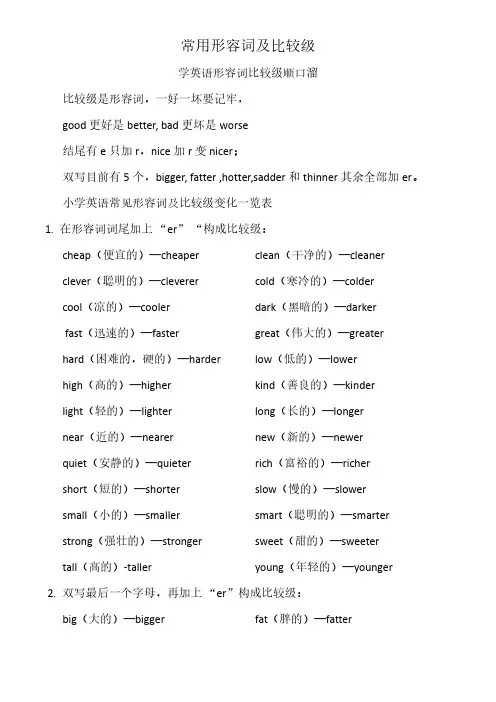
学英语形容词比较级顺口溜比较级是形容词,一好一坏要记牢,good更好是better,bad更坏是worse结尾有e只加r,nice加r变nicer;双写目前有5个,bigger,fatter,hotter,sadder和thinner其余全部加er。
小学英语常见形容词及比较级变化一览表1.在形容词词尾加上“er”“构成比较级:cheap(便宜的)—cheaper clean(干净的)—cleanerclever(聪明的)—cleverer cold(寒冷的)—coldercool(凉的)—cooler dark(黑暗的)—darkerfast(迅速的)—faster great(伟大的)—greaterhard(困难的,硬的)—harder low(低的)—lowerhigh(高的)—higher kind(善良的)—kinderlight(轻的)—lighter long(长的)—longernear(近的)—nearer new(新的)—newerquiet(安静的)—quieter rich(富裕的)—richershort(短的)—shorter slow(慢的)—slowersmall(小的)—smaller smart(聪明的)—smarterstrong(强壮的)—stronger sweet(甜的)—sweetertall(高的)-taller young(年轻的)—younger2.双写最后一个字母,再加上“er”构成比较级:big(大的)—bigger fat(胖的)—fatterhot(热的)—hotter sad(伤心的)—sadderthin(瘦的)—thinner3.以不发音的字母e结尾的形容词,加上“r”构成比较级:close(接近的)—closer fine(好的,完美的)—finer large(巨大的)—larger late(迟的)—laternice(好的)—nicer white(白的)—whiter4.以字母y结尾的形容词,把y改为i,再加上“er”构成比较级:busy(忙碌的)—busier dirty(脏的)—dirtierearly(早的)—earlier easy(容易的)—easierfriendly(友好的)—friendlier pretty(美丽的)—prettier funny(好玩的)—funnier happy(开心的)—happier healthy(健康的)—healthier heavy(重的)—heavierhungry(饿的)—hungrier lazy(懒惰的)—lazierlucky(幸运的)—luckier noisy(嘈杂的)—noisier 5.双音节、多音节形容词,在单词前面加上“more”构成比较级:afraid(害怕的)—more afraidbeautiful(美丽的)—more beautifulcareful(仔细的)—more carefuldelicious(美味的)—more deliciousexciting(令人兴奋的)—more excitingexpensive(昂贵的)—more expensivefamous(著名的)—more famoushard-working(勤奋的)—more hard-workinghelpful(有帮助的)—more helpfulinteresting(有趣的)—more interestingpolite(有礼貌的)—more politetired(累的)—more tired6.不规则变化的形容词:bad(坏的)—worse far(远的)—farthergood(好的)—better ill(病的)—worselittle(少的)—less many(多的)—moremuch(多的)—more well(好的,身体好的)—better old(年老的)—older(elder)。
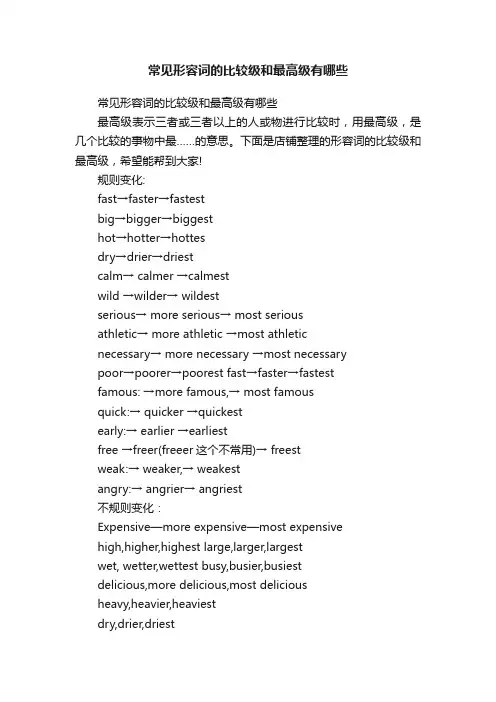
常见形容词的比较级和最高级有哪些常见形容词的比较级和最高级有哪些最高级表示三者或三者以上的人或物进行比较时,用最高级,是几个比较的事物中最……的意思。
下面是店铺整理的形容词的比较级和最高级,希望能帮到大家!规则变化:fast→faster→fastestbig→bigger→biggesthot→hotter→hottesdry→drier→driestcalm→ calmer →calmestwild →wilder→ wildestserious→ more serious→ most seriousathletic→ more athletic →most athleticnecessary→ more necessary →most necessarypoor→poorer→poorest fast→faster→fastestfamous: →more famous,→ most famousquick:→ quicker →qu ickestearly:→ earlier →earliestfree →freer(freeer这个不常用)→ freestweak:→ weaker,→ weakestangry:→ angrier→ angriest不规则变化:Expensive—more expensive—most expensivehigh,higher,highest large,larger,largestwet, wetter,wettest busy,busier,busiestdelicious,more delicious,most deliciousheavy,heavier,heaviestdry,drier,driesteasy easier easiestlazy lazier laziestpretty prettier prettiestnaughty naughtier naughtiestmealy mealier mealiestearly earlier earliestthirsty thirstier thirstiestfar→farther→farthestfar→further→furthestDull—duller--dullestLoud-louder--loudestBoring—more boring—most boringCreative—more creative—most creativeWarm---warmer--warmestgood / well→better→bestbad / ill→worse→worstmany / much→more→mostlittle→less→leastlate→later→ / latestlate→latter→last【拓展】关于形容词和副词的比较级一、含义1. 大多数形容词和副词有三个等级:原级、比较级、最高级: good – better - best2. 比较级:表示两者(人或物)之间的比较。
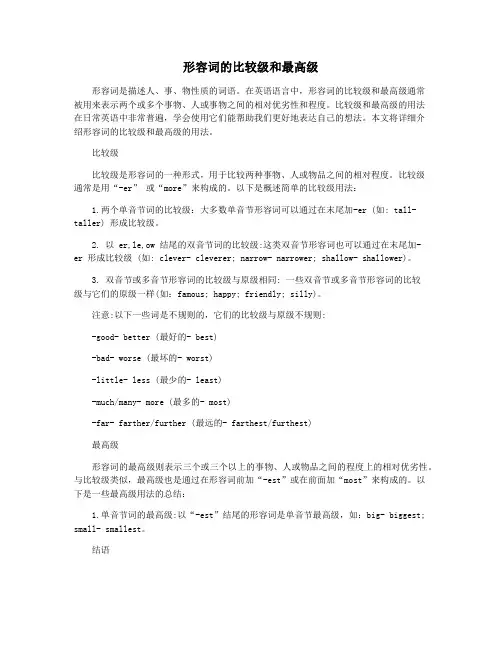
形容词的比较级和最高级形容词是描述人、事、物性质的词语。
在英语语言中,形容词的比较级和最高级通常被用来表示两个或多个事物、人或事物之间的相对优劣性和程度。
比较级和最高级的用法在日常英语中非常普遍,学会使用它们能帮助我们更好地表达自己的想法。
本文将详细介绍形容词的比较级和最高级的用法。
比较级比较级是形容词的一种形式,用于比较两种事物、人或物品之间的相对程度。
比较级通常是用“-er” 或“more”来构成的。
以下是概述简单的比较级用法:1.两个单音节词的比较级:大多数单音节形容词可以通过在末尾加-er (如: tall- taller) 形成比较级。
2. 以 er,le,ow 结尾的双音节词的比较级:这类双音节形容词也可以通过在末尾加-er 形成比较级 (如: clever- cleverer; narrow- narrower; shallow- shallower)。
3. 双音节或多音节形容词的比较级与原级相同: 一些双音节或多音节形容词的比较级与它们的原级一样(如:famous; happy; friendly; silly)。
注意:以下一些词是不规则的,它们的比较级与原级不规则:-good- better (最好的- best)-bad- worse (最坏的- worst)-little- less (最少的- least)-much/many- more (最多的- most)-far- farther/further (最远的- farthest/furthest)最高级形容词的最高级则表示三个或三个以上的事物、人或物品之间的程度上的相对优劣性。
与比较级类似,最高级也是通过在形容词前加“-est”或在前面加“most”来构成的。
以下是一些最高级用法的总结:1.单音节词的最高级:以“-est”结尾的形容词是单音节最高级,如:big- biggest; small- smallest。
结语通过学习形容词比较级和最高级的用法,我们能更加准确地描述不同物品之间的差异程度和相对优劣性。
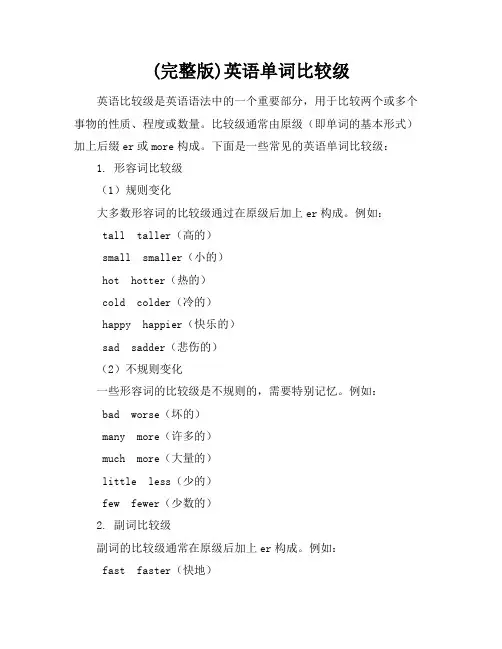
(完整版)英语单词比较级英语比较级是英语语法中的一个重要部分,用于比较两个或多个事物的性质、程度或数量。
比较级通常由原级(即单词的基本形式)加上后缀er或more构成。
下面是一些常见的英语单词比较级:1. 形容词比较级(1)规则变化大多数形容词的比较级通过在原级后加上er构成。
例如:tall taller(高的)small smaller(小的)hot hotter(热的)cold colder(冷的)happy happier(快乐的)sad sadder(悲伤的)(2)不规则变化一些形容词的比较级是不规则的,需要特别记忆。
例如:bad worse(坏的)many more(许多的)much more(大量的)little less(少的)few fewer(少数的)2. 副词比较级副词的比较级通常在原级后加上er构成。
例如:fast faster(快地)slowly more slowly(慢地)carefully more carefully(仔细地)well better(好地)badly worse(坏地)3. 比较级的用法(1)形容词和副词的比较级通常与than连用,构成比较句。
例如:He is taller than me.(他比我高。
)She runs faster than him.(她比他跑得快。
)(2)在比较级前可以使用一些修饰词,如a little, much, far 等,表示比较的程度。
例如:This book is a little more interesting than that one.(这本书比那本更有趣。
)She sings much better than her sister.(她唱歌比她姐姐唱得好多了。
)She is the tallest girl in our class.(她是我们班最高的女孩。
)He runs the fastest in our school.(他是我们学校跑得最快的。
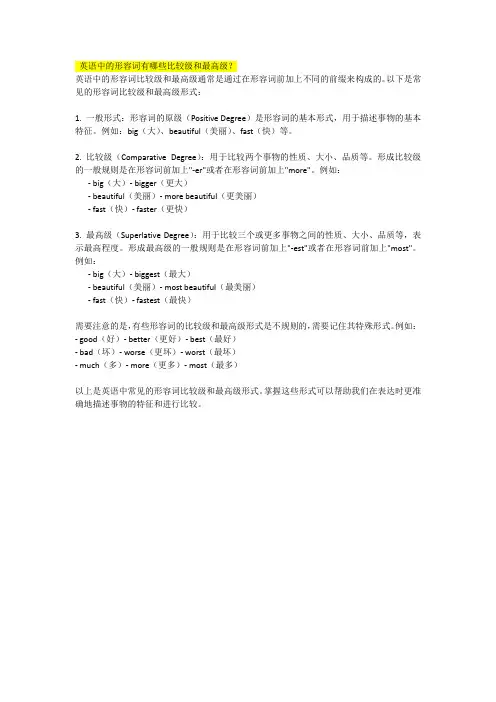
英语中的形容词有哪些比较级和最高级?英语中的形容词比较级和最高级通常是通过在形容词前加上不同的前缀来构成的。
以下是常见的形容词比较级和最高级形式:1. 一般形式:形容词的原级(Positive Degree)是形容词的基本形式,用于描述事物的基本特征。
例如:big(大)、beautiful(美丽)、fast(快)等。
2. 比较级(Comparative Degree):用于比较两个事物的性质、大小、品质等。
形成比较级的一般规则是在形容词前加上"-er"或者在形容词前加上"more"。
例如:- big(大)- bigger(更大)- beautiful(美丽)- more beautiful(更美丽)- fast(快)- faster(更快)3. 最高级(Superlative Degree):用于比较三个或更多事物之间的性质、大小、品质等,表示最高程度。
形成最高级的一般规则是在形容词前加上"-est"或者在形容词前加上"most"。
例如:- big(大)- biggest(最大)- beautiful(美丽)- most beautiful(最美丽)- fast(快)- fastest(最快)需要注意的是,有些形容词的比较级和最高级形式是不规则的,需要记住其特殊形式。
例如:- good(好)- better(更好)- best(最好)- bad(坏)- worse(更坏)- worst(最坏)- much(多)- more(更多)- most(最多)以上是英语中常见的形容词比较级和最高级形式。
掌握这些形式可以帮助我们在表达时更准确地描述事物的特征和进行比较。
形容词变比较级的规律形容词的比较级是英语中用来表示两个或多个事物之间比较高低、优劣、大小、程度等关系的一种形式。
下面是:1. 一般情况下,在形容词的后面加上-er来构成比较级。
例如:- tall(高)→ taller(更高)- fast(快)→ faster(更快)- strong(强壮)→ stronger(更强壮)2. 对于以e结尾的形容词,直接在后面加上-r。
例如:- large(大)→ larger(更大)- cute(可爱)→ cuter(更可爱)3. 对于以辅音字母+y结尾的形容词,要将y改为i,再加上-er。
例如:- happy(快乐)→ happier(更快乐)- pretty(漂亮)→ prettier(更漂亮)4. 以重读闭音节结尾、末尾只有一个辅音字母的词,要双写这个辅音字母再加上-er。
例如:- big(大)→ bigger(更大)- hot(热)→ hotter(更热)5. 一些以不规则形式变化的形容词,要格外注意,比如good(好)要变为better(更好),bad(坏)要变为worse(更坏)。
6. 另一些形容词则是使用more或less来构成比较级。
例如:- beautiful(美丽)→ more beautiful(更美丽)- interesting(有趣)→ more interesting(更有趣)7. 有些特殊的形容词,其比较级和原级是一样的,比如early(早),late(迟),等等。
这些形容词在比较级前面需要加上more或less。
例如:- early(早)→ more early(更早)- late(迟)→ more late(更迟)总的来说,要正确掌握形容词变比较级的规律,需要多加练习,熟练掌握各种形容词的变化规律。
此外,也要注意一些特殊的形容词,不仅要掌握它们的比较级形式,还要理解并运用它们在句子中的用法,从而正确表达出比较的意思。
希望以上内容能够帮助你更好地掌握形容词变比较级的规律。
形容词的比较级和最高级一、含义绝大多数形容词有三种形式,原级,比较级和最高级,以表示形容词说明的性质在程度上的不同。
(1)形容词的原级:形容词的原级形式就是词典中出现的形容词的原形。
例如: poor,tall,great,bad。
(2)形容词的比较级:形容词的比较级表示“更……”,用于两者之间的比较,用来说明“前者比后者更……”,其句式为:“比较级+than”,即:物体A + be动词+ 形比+ than + 物体B。
She is more beautiful than my sister. 她比我的姐姐漂亮。
This bottle is bigger than that one. 这瓶子比那瓶子大。
(3)形容词的最高级:形容词的最高级表示“最......”,表示在三者或三者以上中程度最高,其句式为:the+形容词最高级+(名词)+表示范围的短语或从句,即:物体A + be动词+ the + 形最高级+(名词)+比较范围(of + 人/物,in +地方)Lucy is the most beautiful girl in her school. 露西是她学校最漂亮的女孩。
Jim is the thinnest of the three boys. 吉姆是这三个男孩中最瘦的。
二、比较级和最高级的规则变化(1)单音节和少数双音节形容词变化规则如下:(2)多音节词和部分双音节词变化规则如下:(3)少数不规则变化如下:二、形容词的比较形式1. 比较级:(1) be动词+比较级+than 用于表达“...比...更如何”I am taller than you. 我比你高。
(2) the + 比较级+ of the two表示“两个中比较……的He is the better of the two . 他是这两个人中比较好的。
2. 最高级:be动词+ the + 最高级+ (名词) +比较范围(of + 人/物,in +地方) 用于表达“在...中最......”I am the tallest in our class. 我是我们班里个子最高的。
形容词的比较级与最高级的用法形容词比较级和最高级是英语语法中重要的部分,用来描述人、事物的程度和大小。
了解并正确运用比较级和最高级的用法,可以丰富我们的表达,让文章更生动有趣。
本文将从基本用法、变化规则以及特殊情况等方面介绍形容词的比较级和最高级的使用方法。
一、基本用法比较级用来比较两个人或物的不同之处,最高级则用于三者或三者以上的比较。
比较级常用的结构是:形容词 + er + than;最高级常用的结构是:the + 形容词最高级 + 名词。
例如:1. Tom is taller than Peter.2. He is the smartest student in the class.二、变化规则一般情况下,形容词的比较级和最高级的变化规则如下:1. 单音节或部分双音节形容词,在词尾加-er 和-esttall -> taller -> the tallest2. 以字母e结尾的形容词,在词尾加-r 和-stlarge -> larger -> the largest3. 以辅音字母+y结尾的形容词,将y变为i,再加-er 和-esthappy -> happier -> the happiest4. 多音节形容词或部分双音节形容词,在前面加more 和mostbeautiful -> more beautiful -> the most beautiful特殊情况的变化规则如下:1. 单音节或部分双音节形容词,以辅音字母+y结尾的形容词,如果前面有元音字母,则直接加-er 和-estgray -> grayer -> the grayest2. 以重读闭音节结尾,并且末尾只有一个辅音字母的形容词,则需双写辅音字母,再加-er 和-esthot -> hotter -> the hottest3. 部分双音节形容词和多音节形容词形式副词的形容词,则在前面加more 和mostcarefully -> more carefully -> the most carefully三、用法注意事项1. 形容词比较级和最高级与than 连用,表示与其他人或物相比的差异。
小学英语形容词比较级在英语学习中,形容词的比较级是一个非常基础但重要的概念。
尤其在小学英语中,掌握比较级的用法对于提高英语表达能力和理解能力有着非常关键的作用。
本文将探讨小学英语形容词比较级的基本概念和用法。
一、什么是形容词的比较级?形容词的比较级是用来描述一个事物相对于另一个事物的大小、多少、高低、快慢等方面的相对差异。
在英语中,形容词的比较级通常是通过添加后缀或使用特定的词语来形成的。
二、小学英语形容词比较级的构成在小学英语中,形容词的比较级主要通过以下两种方式构成:1、在形容词后面添加后缀 "-er":例如,"tall"变成 "taller","happy"变成 "happier"。
2、使用 "than"连接两个被比较的事物:例如,"I am taller than you."(我比你高。
)"The cat is happier than the dog."(这只猫比那只狗更开心。
)三、小学英语形容词比较级的用法在英语句子中,我们通常会用到比较级来描述两个或多个事物的相对差异。
在小学英语中,常见的用法包括:1、比较两个事物的差异:例如,"The apple is bigger than the orange."(这个苹果比那个橘子大。
)"John runs faster than Mary."(约翰跑得比玛丽快。
)2、表达自己的喜好或偏好:例如,"I like the blue shirt better than the red one."(比起红色的,我更喜欢蓝色的衬衫。
)"My brother prefers chocolate to ice cream."(我弟弟更喜欢巧克力而不是冰淇淋。
A.形容词的比较分三级:B.单音节形容词在构成比较级和最高级时,在该词原级词尾分别添加er和est:bright brighter brightest以字母e结尾的形容词分别添加r和st:brave braver bravestC.三个或三个以上音节的形容词在构成比较级和最高级时,在该词原级前分别加副词more和most:interested more interested most interestedfrightening more frightening most frightening D.双音节形容词按上述两条规则之一变化。
以ful或re结尾的词通常添加more和most:doubtful more doubtful most doubtfulobscure more obscure most obscure以er,y或ly结尾的通常加er和est:clever cleverer cleverestpretty prettier prettiest(注意y变成i)silly sillier silliestE.不规则的变化有:bad worse worstfar farther farthest(只指距离)further furthest(用处较广;参见F,G)good better bestlittle less leastmany/much more mostold elder eldest(仅指人)older oldest(指人和物)F.farther/farthest和further/furthest这些形式都可以指距离:Y ork is farther/further than Lincoln or Selby.约克要比林肯市或赛尔比市远。
Y ork is the farthest/furthest town.约克是(离这里)最远的城市。
Yhrk is the farthest/furthest of the three.约克是三个城市中(离这里)最远的一个。
(在最后一个句子中farthest/furthest是代名词。
)further同样可以指“另外的/更多的”,主要和抽象名词一起用:Further supplies will soon be available.很快会得到更多的供应。
Further discussion/debate would be pointless.继续讨论/辩论是无意义的。
同理:further enquiries/delays/demands/information/instructions进一步(或更多的)询问/耽搁/要求/报导/指示furthest同样可以和抽象名词连用来表示“最远的”:This was the furthest point they reached in their discussion.他们在讨论中最远就谈到这里。
This was the furthest concession he would make.这是他肯做出的最大的让步。
G.far和near(用于指距离)与比较级和最高级连用时用法都较为灵活:the farthest/furthest mountain最远的山the nearest river最近的一条河这两个形容词的原级用法比较有限。
far和near主要和bank(河岸),end(端,头),side(边),wall(墙)等连用:the far bank河对岸,彼岸the near bank你所在的一边的河岸,此岸near还可以和east(东边)一起用构成the Near East(近东),far可以和north,south,east以及west一起连用构成the farnorth(极北地带),the far south (极南的地方),the Far East(远东)以及the far west(极西部地带)等。
和其他名词连用时far常常被distant(远方的)/remote(遥远的)所代替,near常被nearby (附近的)/neighbouring(邻近的)所代替:a remote island(遥远的岛屿),the neighbouring vil-lage(邻村)。
H.elder,eldest;older,oldestelder和eldest主要表示的是长幼顺序而非年龄大小。
主要用于表示家庭成员之间的长幼关系,如my elder brother(我的兄长/哥哥),her eldest boy/girl(她的长子/长女)。
但在than前不能用elder,只能用older:He is older than I am.他比我年龄大。
英语口语中eldest,oldest和youngest在只有两个男孩/女孩/孩子等时也经常使用:His eldest boy’s at school;the other is still at home.他的大儿子在上学,另一个还呆在家里。
eldest和oldest作代词时,也可以这样用在应当使用比较级的地方:Tom is the eldest.(两人中的)汤姆是长子。
各种表示比较的句子结构A.形容词的原级可与as…as连用表示“和……同样……”,与not as/so…as连用表不“不如……那样……”:A boy of sixteen is often as tall as his father.一个16岁的男孩常常长得和他父亲一样高。
He was as white as a sheet.他面色苍白如纸。
Manslaughter is not as/so bad as murder.杀人罪没有谋杀罪那么重。
Y our coffee is not as/so good as the coffee my mother makes.你煮的咖啡不如我母亲煮的好。
B.形容词比较级可与than连用:The new tower blocks are much higher than the old buildings.新建的塔楼群比旧楼房要高得多。
He makes fewer mistakes than you(do).他犯的错比你少。
He is stronger than I expected.他长得要比我想像的结实。
相当于:I didn’t expect him to be so strong.我没想到他长得这么壮。
It was more expensive than I thought.这比我预料的昂贵多了。
相当于:I didn’t think i t would be so expensive.我没想到它会有这么贵。
如省略than…时,英语口语中常用最高级代替比较级:This is the best way.这是最好的办法。
在只有两种选择时也可用这种表示方法。
C.三个或三个以上的人或物进行比较时,以最高级与the…in/of结构连用的方式来表达:This is the oldest theatre in London.这是伦敦最古老的剧院。
The youngest of the family was the most successful.全家年龄最小的是最有成就的。
关系从句中经常使用完成时态:It/This is the best beer(that)I have ever drunk.这是我所喝过的最好的啤酒。
It/This was the worst film(that)he had ever seen.这是他所看过的电影中最差的一部。
He is the kindest man(that)I have ever met.他是我遇到过的最仁厚的人。
It was the most worrying day(that)he had ever spent.这是他度过的最烦恼的日子。
注意:这里用的是ever而不是never;然而可以把never与比较级连用来表示同一概念:I have never drunk better beer.我从来没喝过这么好的啤酒。
I have never met a kinder man.我从来没遇见过这么仁厚的人。
He had never spent a more worrying day.他从来没有度过这样烦恼的日子。
注意:most+形容词(most前不加the)意为“非常”:Y ou are most kind.相当于:Y ou are very kind.你很好心。
意为“非常”的most主要和双音节或多音节形容词连用,如:annoying(令人烦恼的),apologetic (歉意的),disobedient(不服从的),encouraging(令人鼓舞的),exciting(兴奋的),helpful (有帮助的),important(重要的),misleading(误导的)等。
D.要表达两个事物彼此相应增长时可用the+比较级…the+ 比较级这种结构:House Agent:Do you want a big house?房地产经纪人:你想买一栋大房子吗?Ann:Y es,the bigger the better.安:是的,越大越好。
Tom:But the smaller it is,the less it will cost us to heat.汤姆:可是,房子越小,花的取暖费就越少。
E.一个事物的逐渐增长或减少用两个由and连接的比较级表示:The weather is getting colder and colder.天气越来越冷了。
He became less and less interested.他越来越不感兴趣。
F.用动名词或动词不定式对行为进行比较:Riding a horse is not as easy as riding a motor cycle.骑马不像骑摩托那么容易。
It is nicer/more fun to go with someone than to go alone.偕伴同去比自己独自去好玩。
G.原级与like(相似,介词)和alike连用的结构:Tom is very like Bill.汤姆长得很像比尔。
Bill and Tom are very alike.贝尔和汤姆长得很像。
He keeps the central heating full on.It’s like living in the tropics.他把暖气开到最大。
就好像住在热带一样。
H.原级与like和as连用(下面列举几个副词和形容词的句子)从理论上讲like(介词)只能与名词、代词和动名词连用:He swims like a fish.他游起泳来像条鱼。